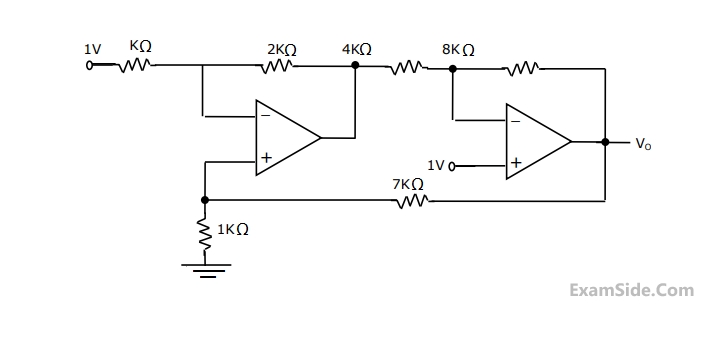1
GATE ECE 1997
Subjective
+5
-0
Consider the circuit given in fig. using an ideal operational Amplifier.


The characteristics of the diode are given by the relation I = Is $$\left[ {{e^{{{qV} \over {KT}}}} - 1} \right],$$
Where V is the forward voltage across the diode
(a)Express V0 as a function of Vi assuming Vi> 0.
(b)If R = 100K$$\Omega $$ , Is = 1$$\mu $$A and $${{KT} \over q}\,\, = \,\,25mV$$
2
GATE ECE 1995
Subjective
+5
-0
Shown that the system in Fig. is a double integrator. In other words, prove that the transfer gain is given by $${{{V_0}\left( s \right)} \over {{V_i}\left( s \right)}} = {1 \over {{{\left( {CRs} \right)}^2}}},$$ assume ideal OP -AMP


3
GATE ECE 1994
Subjective
+5
-0
Find the output voltage of the following circuit assuming ideal op-amp behavior.


4
GATE ECE 1993
Subjective
+5
-0
Find the output voltage, V0 in the following circuit assuming that the Op-Amps are ideal.


Questions Asked from Operational Amplifier (Marks 5)
Number in Brackets after Paper Indicates No. of Questions
GATE ECE Subjects
Network Theory
Control Systems
Electronic Devices and VLSI
Analog Circuits
Digital Circuits
Microprocessors
Signals and Systems
Representation of Continuous Time Signal Fourier Series Fourier Transform Continuous Time Signal Laplace Transform Discrete Time Signal Fourier Series Fourier Transform Discrete Fourier Transform and Fast Fourier Transform Discrete Time Signal Z Transform Continuous Time Linear Invariant System Discrete Time Linear Time Invariant Systems Transmission of Signal Through Continuous Time LTI Systems Sampling Transmission of Signal Through Discrete Time Lti Systems Miscellaneous
Communications
Electromagnetics
General Aptitude